Plastic Bottles Market Size
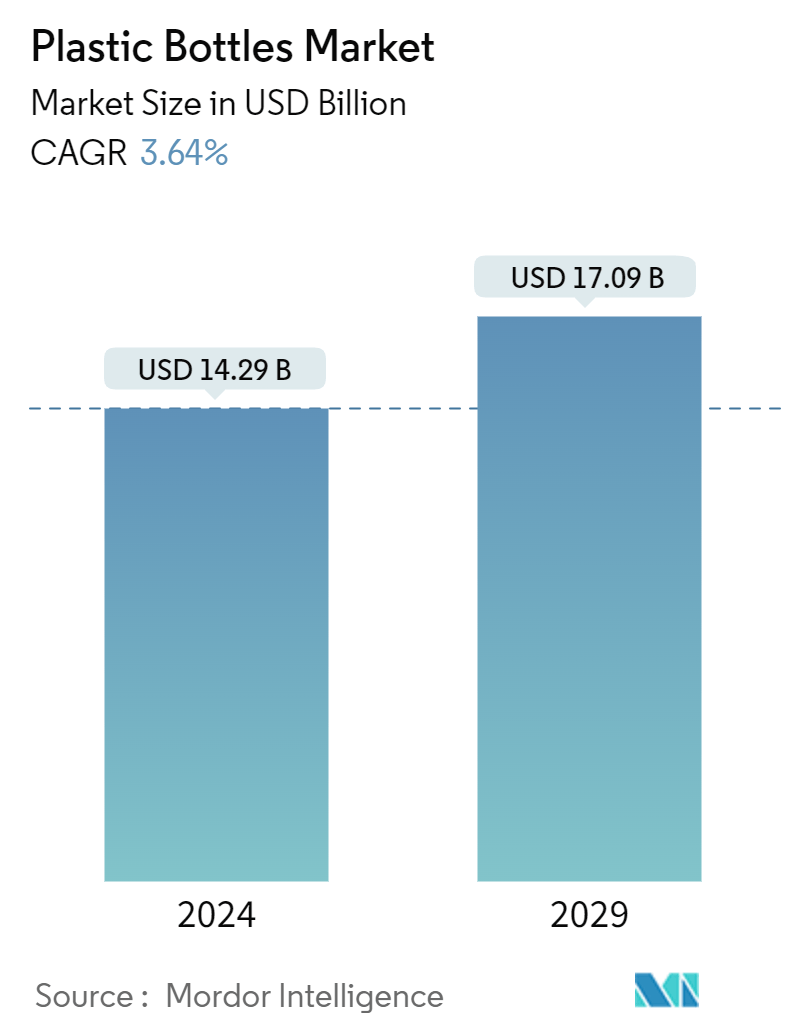
| Study Period | 2019 - 2029 |
| Market Size (2024) | USD 14.29 Billion |
| Market Size (2029) | USD 17.09 Billion |
| CAGR (2024 - 2029) | 3.64 % |
| Fastest Growing Market | Asia Pacific |
| Largest Market | Asia Pacific |
Major Players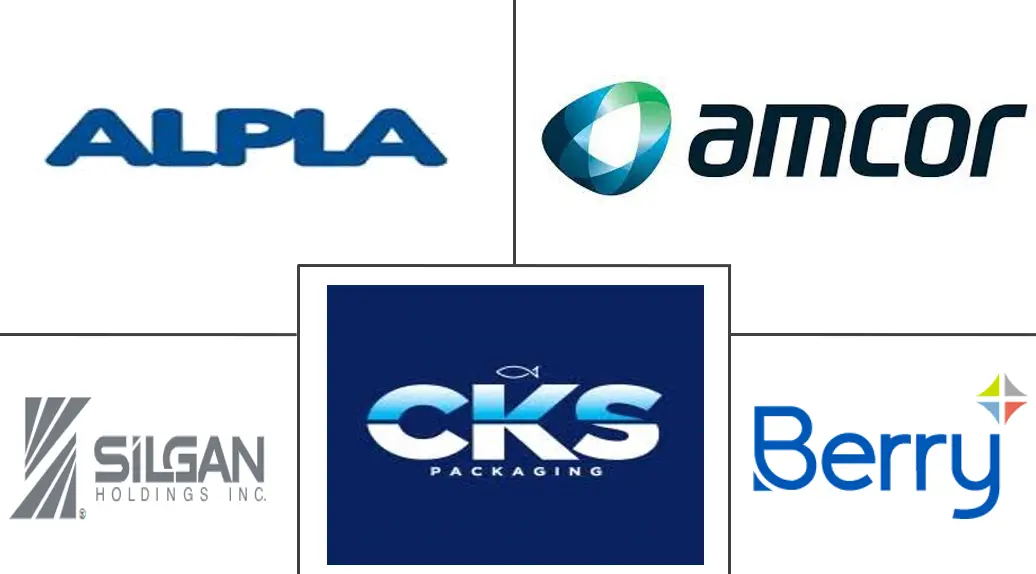
*Disclaimer: Major Players sorted in no particular order |
Plastic Bottles Market Analysis
The Plastic Bottles Market size is estimated at USD 14.29 billion in 2024, and is expected to reach USD 17.09 billion by 2029, growing at a CAGR of 3.64% during the forecast period (2024-2029). In terms of production volume, the market is expected to grow from 15.39 billion tonnes in 2024 to 18.20 billion tonnes by 2029, at a CAGR of 3.42% during the forecast period (2024-2029).
Consumers globally increasingly favor plastic packaging due to its lightweight nature and ease of handling. Major manufacturers are gravitating toward plastic packaging solutions, primarily for their cost-effectiveness in production.
- Manufacturers widely favor plastic bottles crafted from materials like polyethylene terephthalate, polypropylene, and polyethylene. These materials are lightweight and unbreakable, enhancing the ease of handling. Additionally, manufacturers lean toward plastic packaging due to its cost-effectiveness. Given the rising reliance on packaged and processed foods and diverse beverages, the market for plastic bottles and containers is poised for growth during the forecast period.
- PET has become a vital packaging material among bottle manufacturers across the region. Its versatility in accommodating different shapes and sizes has provided unparalleled alternatives to conventional glass and metal containers, making it a highly desirable choice in the packaging industry.
- According to a report by PETnology, a global packaging networking platform, in July 2023, Asia is expected to take the lead in global PET industry capacity expansions, driven by new construction and expansion initiatives set to take place after 2023.
- Manufacturers prefer PET over other plastic packaging products, as it has a minimum loss of raw material during the manufacturing process compared to other plastic products. Its recyclability and the feature of adding multiple colors and designs augment it to become a preferred choice. Refillable products have emerged with rising consumer awareness of the environment and have acted to create demand for the product.
- As consumers increasingly prioritize high-quality drinking water, driven by concerns over tainted tap water and the inherent convenience of portability, the demand for bottled water surges. This growing appetite for bottled water, alongside the rising popularity of non-alcoholic beverages, is set to propel the plastic bottle market within the beverage industry.
- However, there is a growing inclination toward other packaging materials that offer environment-friendly properties. The consumption of aluminum cans and glass bottles has been witnessing high adoption rates in the region owing to its eco-friendly nature and high recyclability. Thus, consumers have been increasingly moving toward other materials from plastic.
Plastic Bottles Market Trends
The Beverages Segment is Expected to Drive the Market's Growth
- The beverage segment is anticipated to witness growth, owing to the never-ending demand for bottled water and non-alcoholic beverages. The demand for bottled water is credited to consumers' propensity for specifically demanding high-quality drinking water, owing to the fear of diseases as an aftermath of drinking polluted tap water and the ease of portability and convenience provided by bottled water.
- Further, in many developed and developing economies, people favor bottled water. Bottled water is sold in stores and places selling various drinks. For instance, the International Bottled Water Association (IBWA) stated that Americans favor bottled water over other packaged beverages.
- According to Beverage Marketing Corporation data published in May 2023, in 2022, the United States bottled water sales reached 15.9 billion gallons, marking a consistent annual increase over the past decade. With the rise in bottled water volume sales in recent years, the demand for plastic bottles surged nationwide.
- PET bottles are more prevalent in the water packaging market than glass and plastic bottles due to their durability and recyclability characteristics. The trend shows that lightweight, durable, and cost-effective PET is increasingly becoming the packaging medium of water.
- The consumption of water bottles is an increasing trend across China and India with the growing population and changing lifestyle, creating demand for different formats of bottles that are lightweight, easy to carry, and can be stored and fulfill all the regulation terms to cater to changing consumer trends toward sustainability.
- Companies also innovate different formats of bottled water, which are new in the market, and provide opportunities for the companies to promote the bottle with unique strategies to create market buzz.
- For instance, in India, Wahter introduced ISI-certified bottled water in December 2023, which can be branded by advertisers at the lowest cost, leveraging 80% of branding space where advertisers can set up an account for their brand, upload their design, and link it to the template of the label advertisers to tailor their marketing strategies to their target audience.
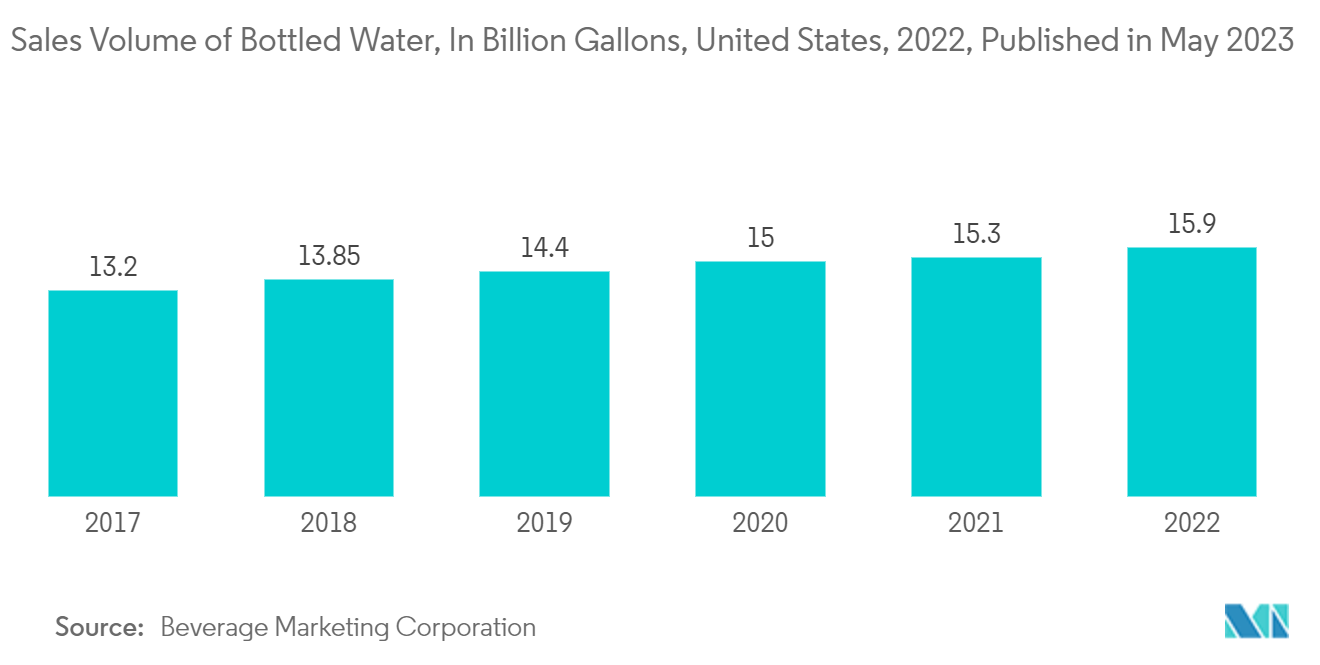
Asia-Pacific is Expected to Witness the Highest Growth
- One of the main initiatives across multiple countries in Asia-Pacific has generally been to cut down the usage of single-use plastic bottles and packaging. Companies might likely resort to plastic packaging to combat the pandemic's spread, putting the sustainability aspect away at this time.The healthcare and pharmaceutical sectors in China, India, and Japan are the world's largest markets, primarily driven by the aging population.
- According to the Organisation of Pharmaceutical Producers of India, the country's pharmaceutical market is expected to reach USD 450 billion by 2047, which is up from USD 49 billion in 2022. Hence, there is a possibility for growth for domestic players as they might experience an increase in demand for plastic bottles from these companies. The Indian plastic bottle market is estimated to grow steadily, owing to the continually increasing consumption and industrial applications of plastic-made bottles.
- Further, India is also one of the strong markets in the region with the highest population, and with a developing and trending outlook, there is a significant increase in the consumption of bottled water. Indian Railway Catering and Tourism Corporation Limited has launched a pet bottled water brand, "Rail Neer," which is majorly sold on trains and railway stations; with the rising consumption of water bottles and the growing railway sector, the corporation increased the production of the bottles in 2021 with 75.30 bottles produced which increased to 357.70 million bottles in 2023.
- PET bottles are more energy efficient than glass bottles while delivering 1000 gallons of soft drinks and contribute less solid waste by weight than glass and aluminum containers. Thus, companies are shifting to PET format for carbonated beverages and innovating bottles with recycled materials due to changing consumer preferences in the region.
- For instance, in Hong Kong, as part of its efforts to reduce its environmental footprint, the Coca-Cola Company announced the launch of 500 ml bottles made entirely from recycled plastic for its flagship drink, Coke, in April 2024. The global beverage company announced
that all 500 ml bottles of Coca-Cola Original, Coca-Cola No Sugar, and Coca-Cola Plus in production in China have shifted to 100% recycled polyethylene terephthalate (rPET).
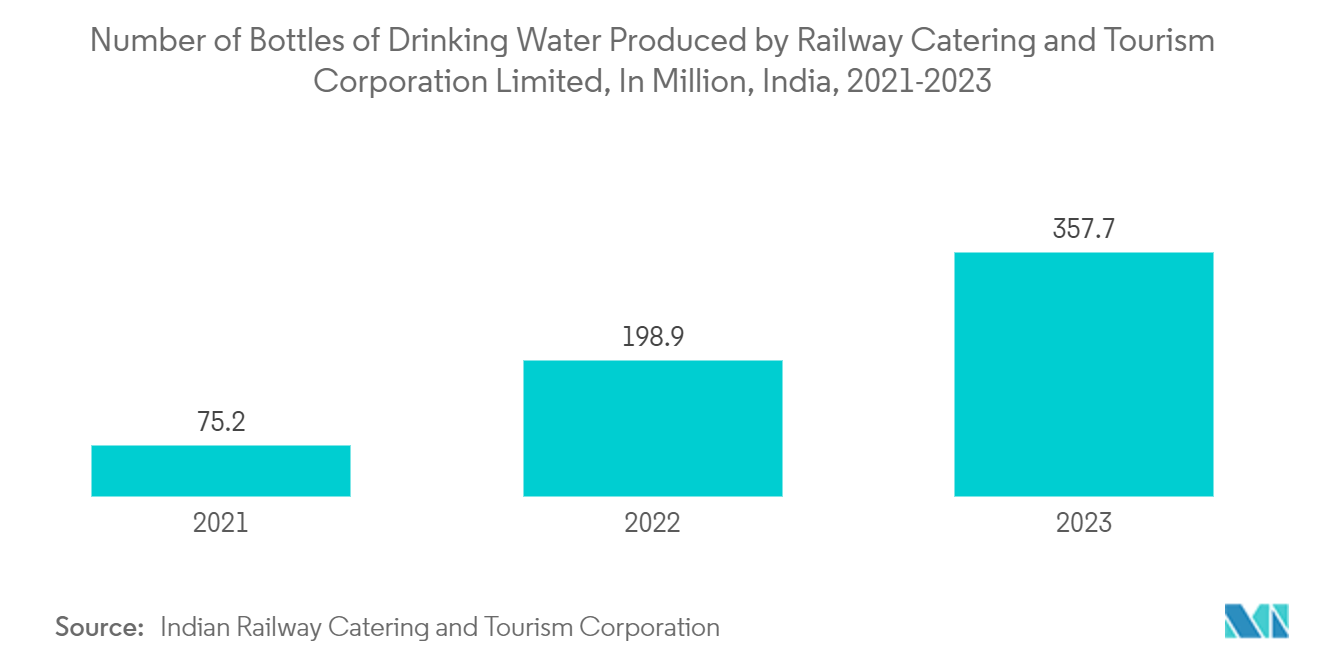
Plastic Bottles Industry Overview
The plastic bottles market is fragmented and consists of several major players. In terms of market share, few of the major players currently dominate the market. These players, with a prominent share of the market, are focusing on expanding their customer base across foreign countries. These companies are leveraging strategic collaborative initiatives to increase their market share and profitability. Some of the recent developments in the market are:
- May 2024: ALPLA, a key firm in plastic packaging, unveiled a new recyclable wine bottle crafted from polyethylene terephthalate (PET). This innovative packaging slashes carbon footprints by as much as 50% and offers potential cost savings of up to 30%. Currently, bottles offered in 750 ml and one-liter sizes are being used by Austrian wine producer Wegenstein, marking them as both a pilot customer and a collaborative development partner.
- August 2023: Berry Global unveiled an innovative rPET bottle for a new sustainable luxury brand. Leveraging its technical prowess and extensive experience with recycled plastics, Berry brought to life the original design vision of NEUE Water’s founder, Michael Lowers. The unconventional flat shape posed challenges to the traditional injection stretch blow molding (ISBM) process used for PET bottles. However, Berry adeptly modified the technology to integrate the novel design seamlessly.
Plastic Bottles Market Leaders
-
Amcor Group GmbH
-
ALPLA Group
-
Berry Global Group, Inc.
-
Silgan Holdings Inc.
-
CKS Packaging Inc.
*Disclaimer: Major Players sorted in no particular order
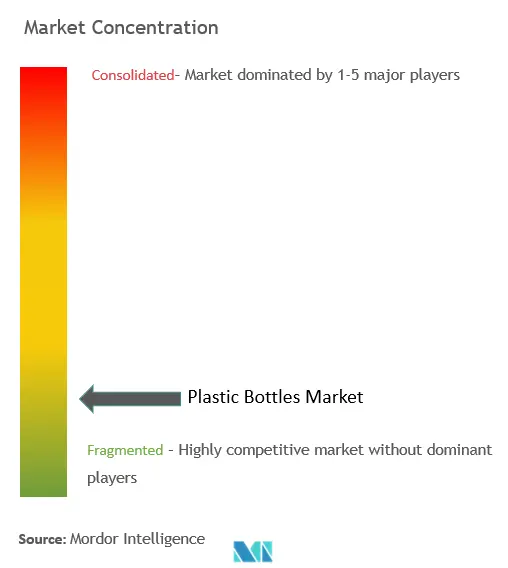
Plastic Bottles Market News
- June 2024: Berry Global Group Inc., a global leader in sustainable packaging, unveiled a customizable rectangular Domino bottle. This new offering, designed for the beauty, home, and personal care markets, can be made with 100% post-consumer recycled (PCR) plastic. The 250 ml Domino bottle features a 75-millimeter-wide front face and side panels that can be tailored to brand needs.
- April 2024: Amcor PLC unveiled a groundbreaking 1l carbonated soft drink (CSD) bottle crafted entirely from post-consumer recycled (PCR) polyethylene terephthalate (PET) material. According to the company, this pioneering stock bottle enables beverage brands to address rising sustainability demands and regulations, all while speeding up their market entry.
Plastic Bottle Market Report - Table of Contents
1. INTRODUCTION
- 1.1 Study Assumptions and Market Definition
- 1.2 Scope of the Study
2. RESEARCH METHODOLOGY
3. EXECUTIVE SUMMARY
4. MARKET DYNAMICS
- 4.1 Market Overview
-
4.2 Industry Attractiveness - Porter's Five Forces Analysis
- 4.2.1 Bargaining Power of Suppliers
- 4.2.2 Bargaining Power of Buyers
- 4.2.3 Threat of New Entrants
- 4.2.4 Threat of Substitute Products
- 4.2.5 Intensity of Competitive Rivalry
- 4.3 Industry Value Chain Analysis
5. MARKET DYNAMICS
-
5.1 Market Drivers
- 5.1.1 Growing Recycling and Oher Cost-effective Initiatives are Bolstering the Demand
- 5.1.2 Increasing Demand from the Beverage Industry aids the Market
-
5.2 Market Challenges
- 5.2.1 Environmental Concerns Regarding the Use of Plastics
-
5.3 Trade Scenario
- 5.3.1 EXIM Data
- 5.3.2 Trade Analysis (Top 5 Import-Export Countries)
- 5.4 Industry Regulations, Policies, and Standards
- 5.5 Technology Landscape
-
5.6 Pricing Trend Analysis
- 5.6.1 Plastic Resins (Current Pricing and Historic Trends)
6. MARKET SEGMENTATION
-
6.1 By Resin
- 6.1.1 Polyethylene (PE)
- 6.1.2 Polyethylene Terephthalate (PET)
- 6.1.3 Polypropylene (PP)
- 6.1.4 Other Resins (Polystyrene, PVC, Polycarbonate, etc.)
-
6.2 By End-user Industry
- 6.2.1 Food
- 6.2.2 Beverage
- 6.2.2.1 Bottled Water
- 6.2.2.2 Carbonated Soft Drinks
- 6.2.2.3 Alcoholic Beverages
- 6.2.2.4 Juices and Energy Drinks
- 6.2.2.5 Other Beverages
- 6.2.3 Pharmaceuticals
- 6.2.4 Personal Care and Toiletries
- 6.2.5 Industrial
- 6.2.6 Household Chemicals
- 6.2.7 Paints and Coatings
- 6.2.8 Other End-user Industries
-
6.3 By Geography***
- 6.3.1 North America
- 6.3.1.1 United States
- 6.3.1.2 Canada
- 6.3.2 Europe
- 6.3.2.1 France
- 6.3.2.2 Germany
- 6.3.2.3 Italy
- 6.3.2.4 United Kingdom
- 6.3.2.5 Spain
- 6.3.2.6 Poland
- 6.3.2.7 Nordic
- 6.3.3 Asia-Pacific
- 6.3.3.1 China
- 6.3.3.2 India
- 6.3.3.3 Japan
- 6.3.3.4 Thailand
- 6.3.3.5 Australia and New Zealand
- 6.3.3.6 Indonesia
- 6.3.3.7 Vietnam
- 6.3.4 Latin America
- 6.3.4.1 Brazil
- 6.3.4.2 Mexico
- 6.3.4.3 Colombia
- 6.3.5 Middle East and Africa
- 6.3.5.1 United Arab Emirates
- 6.3.5.2 Saudi Arabia
- 6.3.5.3 Egypt
- 6.3.5.4 South Africa
- 6.3.5.5 Nigeria
- 6.3.5.6 Morocco
7. COMPETITIVE LANDSCAPE
-
7.1 Company Profiles*
- 7.1.1 Amcor Group GmbH
- 7.1.2 ALPLA Group
- 7.1.3 Silgan Holdings Inc.
- 7.1.4 Berry Global Inc.
- 7.1.5 CKS Packaging Inc.
- 7.1.6 Comar LLC
- 7.1.7 Alpack Plastic Packaging
- 7.1.8 Cospack America Corporation
- 7.1.9 Resilux NV
- 7.1.10 Greiner Packaging
- 7.1.11 Altium Packaging
- 7.1.12 Plastikpak Holding Inc.
- 7.1.13 Container Corporation of Canada
- 7.1.14 Sailor Plastics Inc.
- 7.2 Heat Map Analysis
- 7.3 Competitor Analysis - Emerging vs. Established Players
8. RECYCLING AND SUSTAINABILITY LANDSCAPE
9. FUTURE OUTLOOK
** Subject To AvailablityPlastic Bottles Industry Segmentation
Plastic bottles generally include single-use and recyclable bottles made of plastic resins, such as PET, PP, and PE. These bottles are used by a comprehensive end-user industry, including food, beverage, and personal care. The plastic bottles market report offers an up-to-date analysis of the current market scenario, the latest trends and drivers, and the overall market environment. The study also identifies the continuous development of new products as a prime reason driving the plastic bottle market's growth during the next few years.
The plastic bottles market is segmented by resins (polyethylene (PE), polyethylene terephthalate (PET), polypropylene (PP), and other resins), end-user industry (food, beverage [bottled water, carbonated soft drinks, alcoholic beverages, juices and energy drinks, and other beverages], pharmaceutical, personal care and toiletries, industrial and household chemicals, paints and coatings, and other end-user industries), and geography (North America [United States and Canada], Europe [United Kingdom, Germany, France, Italy, Spain, Poland, Nordic, and the rest of Europe], Asia-Pacific [China, India, Japan, Thailand, Indonesia, Vietnam, Australia and New Zealand, and rest of Asia-Pacific], Latin America [Brazil, Colombia, Mexico, and rest of Latin America], and Middle East and Africa [Saudi Arabia, United Arab Emirates, Egypt, South Africa, Nigeria, Morocco, and rest of the Middle East and Africa]. The report offers market forecasts and size in volume (tonnes) and value (USD) for all the above segments.
| By Resin | Polyethylene (PE) | |
| Polyethylene Terephthalate (PET) | ||
| Polypropylene (PP) | ||
| Other Resins (Polystyrene, PVC, Polycarbonate, etc.) | ||
| By End-user Industry | Food | |
| Beverage | Bottled Water | |
| Carbonated Soft Drinks | ||
| Alcoholic Beverages | ||
| Juices and Energy Drinks | ||
| Other Beverages | ||
| Pharmaceuticals | ||
| Personal Care and Toiletries | ||
| Industrial | ||
| Household Chemicals | ||
| Paints and Coatings | ||
| Other End-user Industries | ||
| By Geography*** | North America | United States |
| Canada | ||
| By Geography*** | Europe | France |
| Germany | ||
| Italy | ||
| United Kingdom | ||
| Spain | ||
| Poland | ||
| Nordic | ||
| By Geography*** | Asia-Pacific | China |
| India | ||
| Japan | ||
| Thailand | ||
| Australia and New Zealand | ||
| Indonesia | ||
| Vietnam | ||
| By Geography*** | Latin America | Brazil |
| Mexico | ||
| Colombia | ||
| By Geography*** | Middle East and Africa | United Arab Emirates |
| Saudi Arabia | ||
| Egypt | ||
| South Africa | ||
| Nigeria | ||
| Morocco |
Plastic Bottle Market Research FAQs
How big is the Plastic Bottles Market?
The Plastic Bottles Market size is expected to reach USD 14.29 billion in 2024 and grow at a CAGR of 3.64% to reach USD 17.09 billion by 2029.
What is the current Plastic Bottles Market size?
In 2024, the Plastic Bottles Market size is expected to reach USD 14.29 billion.
Who are the key players in Plastic Bottles Market?
Amcor Group GmbH, ALPLA Group, Berry Global Group, Inc., Silgan Holdings Inc. and CKS Packaging Inc. are the major companies operating in the Plastic Bottles Market.
Which is the fastest growing region in Plastic Bottles Market?
Asia Pacific is estimated to grow at the highest CAGR over the forecast period (2024-2029).
Which region has the biggest share in Plastic Bottles Market?
In 2024, the Asia Pacific accounts for the largest market share in Plastic Bottles Market.
What years does this Plastic Bottles Market cover, and what was the market size in 2023?
In 2023, the Plastic Bottles Market size was estimated at USD 13.77 billion. The report covers the Plastic Bottles Market historical market size for years: 2019, 2020, 2021, 2022 and 2023. The report also forecasts the Plastic Bottles Market size for years: 2024, 2025, 2026, 2027, 2028 and 2029.
Plastic Bottle Industry Report
Statistics for the 2024 Plastic Bottle market share, size and revenue growth rate, created by Mordor Intelligence™ Industry Reports. Plastic Bottle analysis includes a market forecast outlook to 2029 and historical overview. Get a sample of this industry analysis as a free report PDF download.



